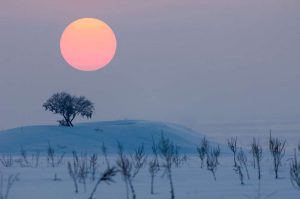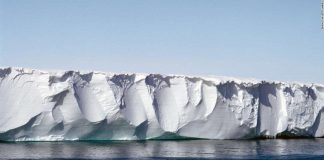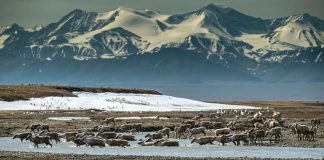JANUARY 22, 2019
 Wednesday is special in Utqiagvik, formerly known as Barrow, Alaska, for reasons that don’t sound particularly special. That morning, the sun will rise there — but for the first time in 66 days.
Wednesday is special in Utqiagvik, formerly known as Barrow, Alaska, for reasons that don’t sound particularly special. That morning, the sun will rise there — but for the first time in 66 days.
The country’s northernmost town, with a population of 4,300 people, is also one of the northernmost communities in the world, at a latitude of 71.2 degrees north. That puts it well into the Arctic Circle, where polar night — the part of winter when the sun doesn’t come above the horizon — casts months of darkness.
Utqiagvik hasn’t seen the sun since Nov. 18. On Wednesday, a fleeting segment of the sun will appear in the south beginning at 1:04 p.m. local time and will sink below the horizon about an hour later, at 2:14 p.m. The solar disc will never be more than halfway above the horizon, so odds are that it will be impossible to see from the town, unless residents’ view is free of buildings, trees or even shrubs at ground level.
The change in daylight between the seasons gets more extreme toward the poles. While winter is long, dark and cruel in Utqiagvik, residents also enjoy more than two months of endless daylight in the summertime. Talk about a long day!
That dramatic flip of the coin is thanks to Earth’s tilt. The planet leans about 23.5 degrees on its axis, explaining why globes are assembled intentionally off-kilter.
In the summer, the north pole of the axis tilts toward the sun, and the Northern Hemisphere gets the most direct sunlight. The days get long, and sunlight warms the ground. In places at the “top of the world,” such as northern Alaska, the sun is up 24/7. In the winter, the opposite is true.
Utqiagvik’s days will gradually lengthen until May 12, when the sun won’t set until Aug. 2. This increase in daylight is most extreme in the coming weeks: Thursday will feature 33 more minutes of daylight than Wednesday, and by the weekend, Utqiagvik will be basking in sunlight for more than two and a half hours each day.
Even though Utqiagvik sees two straight months of sunlight in the summer, the average July high temperature is only 47 degrees. That’s because the sun is shining at a very low angle, so Utqiagvik catches only the fringes of sunlight stretched over a broader area. A beam of light has to cover more territory at the poles than the equator, so it’s less effective at heating the ground.
In the winter, extreme cold sets in. Utqiagvik’s average nightly low in February is minus-20. The temperature hasn’t climbed above 32 degrees since Nov. 1. Interestingly, Utqiagvik gets less snow than Boston or Denver, as it’s so cold that hardly any water makes it into the air.
Courtesy/Source: Washington Post

































































































